Energy
Visualizing the Flow of U.S. Energy Consumption
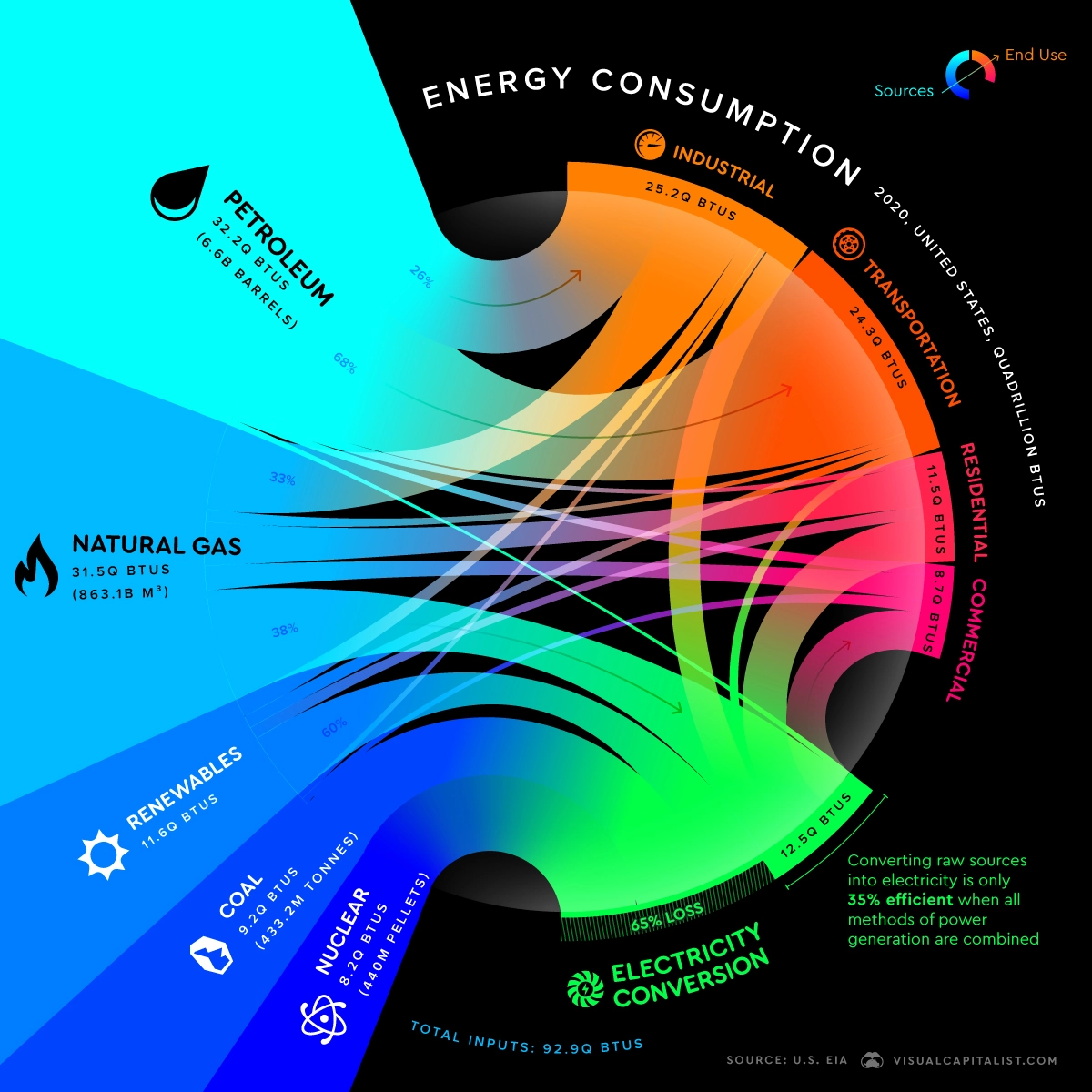
Breaking Down America’s Energy Consumption in 2020
This was originally published on July 6 2021, on Visual Capitalist.
The United States relies on a complex mix of energy sources to fuel the country’s various end-sectors’ energy consumption.
While this energy mix is still dominated by fossil fuels, there are signs of a steady shift to renewable energy over the past decade.
This radial Sankey diagram using data from the EIA (Energy Information Administration) breaks down U.S. energy consumption in 2020, showing us how much each sector relies on various energy sources.
The Balance of Energy Production and Consumption
In 2019 and now in 2020, America’s domestic energy production has actually been greater than its consumption—a development that hasn’t taken place since 1957.
Last year’s numbers were severely impacted by the COVID-19 pandemic, seeing a 5% drop in energy production and a 7% drop in consumption compared to 2019. Total energy production and consumption for 2020 came in at 95.75 and 92.94 quads respectively.
The energy amounts are equalized and measured in quadrillion BTUs (British thermal units), also known as quads. A quad is a huge amount of energy, equivalent to 183 million barrels of petroleum or 36 million tonnes of coal.
So how is America’s overall energy production and consumption split between energy sources?
U.S. Energy Production and Consumption Share by Source
| Energy Source | Percentage of U.S. Energy Production | Percentage of U.S. Energy Consumption |
|---|---|---|
| Petroleum | 32% | 35% |
| Natural Gas | 36% | 34% |
| Renewable Energy | 12% | 12% |
| Coal | 11% | 10% |
| Nuclear | 9% | 9% |
Source: IEA
America’s new margin of energy production over consumption has resulted in the country being a net total energy exporter again, providing some flexibility as the country continues its transition towards more sustainable and renewable energy sources.
Fossil Fuels Still Dominate U.S. Energy Consumption
While America’s mix of energy consumption is fairly diverse, 79% of domestic energy consumption still originates from fossil fuels. Petroleum powers over 90% of the transportation sector’s consumption, and natural gas and petroleum make up 74% of the industrial sector’s direct energy consumption.
There are signs of change as consumption of the dirtiest fossil fuel, coal, has declined more than 58% since its peak in 2005. Coinciding with this declining coal dependence, consumption from renewable energy has increased for six years straight, setting record highs again in 2020.
However, fossil fuels still make up 79% of U.S. energy consumption, with renewables and nuclear accounting for the remaining 21%. The table below looks at the share of specific renewable energy sources in 2020.
Distribution of Renewable Energy Sources
| Renewable Energy Source | 2020 Energy Consumption in Quads | Share of 2020 Renewable Energy Consumption |
|---|---|---|
| Biomass | 4.52 | 39% |
| Wind | 3.01 | 26% |
| Hydroelectric | 2.55 | 22% |
| Solar | 1.27 | 11% |
| Geothermal | 0.23 | 2% |
Source: IEA
The Nuclear Necessity for a Zero-Emission Energy Transition
It’s not all up to renewable energy sources to clean up America’s energy mix, as nuclear power will play a vital role in reducing carbon emissions. Technically not a renewable energy source due to uranium’s finite nature, nuclear energy is still a zero-emission energy that has provided around 20% of total annual U.S. electricity since 1990.
Support for nuclear power has been growing slowly, and last year was the first which saw nuclear electricity generation overtake coal. However, this might not last as three nuclear plants including New York’s Indian Point nuclear plant are set to be decommissioned in 2021, with a fourth plant scheduled for retirement in 2022.
It’s worth noting that while other countries might have a higher share of nuclear energy in their total electricity generation, the U.S. still has the largest nuclear generation capacity worldwide and has generated more nuclear electricity than any other country in the world.
Converting Energy to Electricity
The energy produced by nuclear power plants doesn’t go directly to its end-use sector, rather, 100% of nuclear energy in the U.S. is converted to electricity which is sold to consumers. Along with nuclear, most energy sources aside from petroleum are primarily converted to electricity.
Unfortunately, electricity conversion is a fairly inefficient process, with around 65% of the energy lost in the conversion, transmission, and distribution of electricity.
This necessary but wasteful step allows for the storage of energy in electrical form, ensuring that it can be distributed properly. Working towards more efficient methods of energy to electricity conversion is an often forgotten aspect of reducing wasted energy.
Despite the dip in 2020, both energy production and consumption in the U.S. are forecasted to continue rising. As Biden aims to reduce greenhouse gas emissions by 50% by 2030 (from 2005 emission levels), U.S. energy consumption will inevitably continue to shift away from fossil fuels and towards renewable and nuclear energy.
Energy
Visualizing U.S. Electricity Generation Jobs by Technology
Exploring U.S. electricity generation jobs by technology with a focus on renewable energy and workforce development.
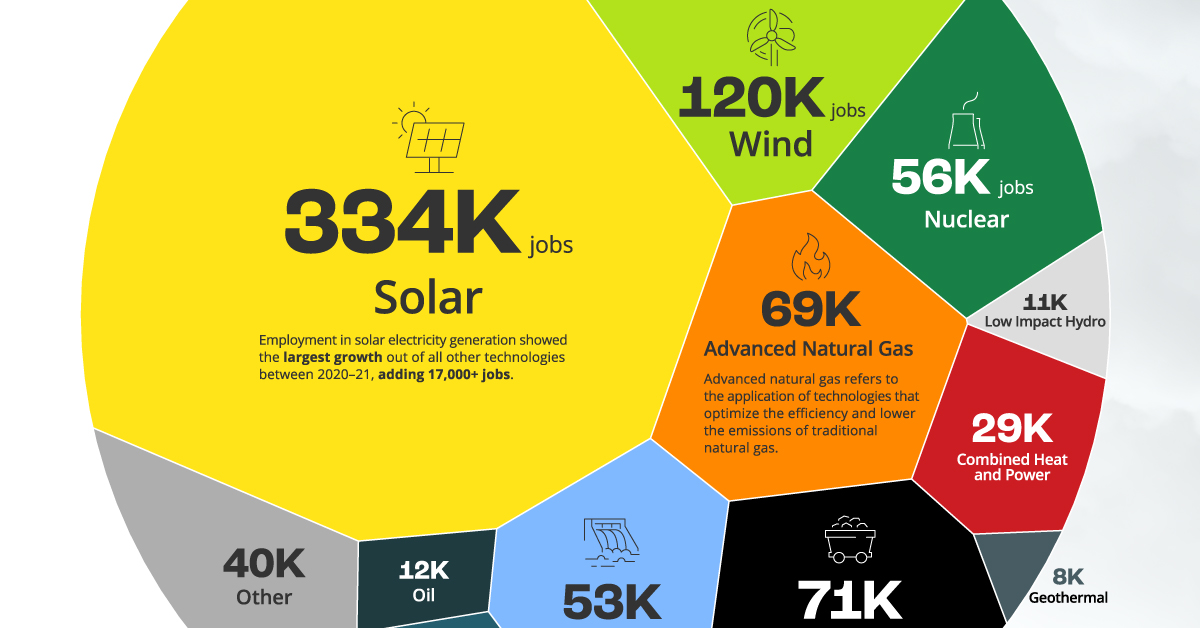
Visualizing U.S. Electricity Generation Jobs by Technology
In 2021, 857,579 people were employed in the U.S. electricity generation sector.
To explore the distribution of this workforce, the above graphic by the National Public Utilities Council breaks down the number of jobs for each electricity generation technology using the U.S. Department of Energy’s Energy and Employment Report.
An Evolving Employment Landscape
The employment landscape within the U.S. electricity generation sector is continually evolving, driven by technological shifts, growing urgency towards decarbonization, and new policy initiatives.
Here are some interesting trends seen in 2021.
1. Solar Leads the Way with Significant Job Growth
The solar energy sector emerged as a shining star in 2021, witnessing substantial job growth compared to other electricity generation technologies. With a total of 333,887 jobs, solar not only topped the chart but also experienced a notable increase of over 17,000 jobs from the previous year.
This surge in solar jobs can be attributed to several factors, including advancements in technology, falling costs, and increased adoption of renewable energy sources across the country.
2. Advanced Natural Gas Employs More People Than Traditional
While renewable energy sources gained traction, advanced natural gas also played a significant role in the U.S. electricity generation sector with 69,113 jobs.
Advanced natural gas refers to the application of technologies that optimize efficiency and reduce the emissions associated with traditional natural gas.
As the fourth biggest employer on the list, advanced natural gas employed more people than traditional natural gas in 2021.
3. Renewable Energy Sector Outpaces Broader Sector Growth
Between 2020 and 2021, the renewable electricity generation sector experienced a robust growth rate of 4.4% in employment, outpacing the broader power generation sector’s growth rate of 2.9%.
The employment figures highlight the potential for continued job creation within the renewable sector as the transition to cleaner energy sources gains further momentum.
Getting Over the Workforce Development Hurdle
The employment figures in the U.S. electricity generation sector demonstrate promising growth in clean energy jobs. With that said, rapid decarbonization of the sector may still require a level of workforce development that hasn’t yet been seen in the United States.
As electric utilities and the nation at large strive to achieve their ambitious net-zero goals, investing more in workforce development can be an integral piece of the puzzle, specifically to help individuals transition smoothly from fossil fuel jobs to those in clean generation.
By addressing this challenge, the U.S. can ensure a well-prepared workforce that will drive the transition to a sustainable and net-zero future.
Energy
How Does U.S. Electricity Generation Change Over One Week?
This chart tracks U.S. hourly electricity generation over one week, with various sources producing electricity at different times of the day.
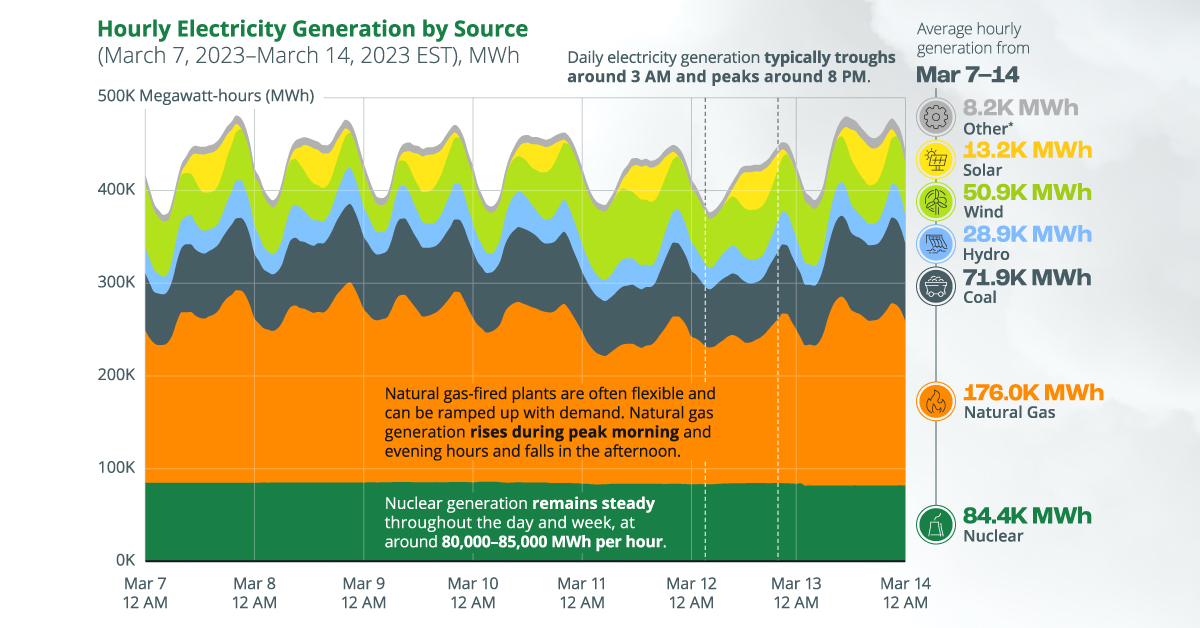
How Does U.S. Electricity Generation Change in a Week?
The U.S. has a dynamic electricity mix, with a range of energy sources generating electricity at different times of the day.
At all times, the amount of electricity generated must match demand in order to keep the power grid in balance, which leads to cyclical patterns in daily and weekly electricity generation.
The above graphic sponsored by the National Public Utilities Council tracks hourly changes in U.S. electricity generation over one week, based on data from the U.S. Energy Information Administration (EIA).
The Three Types of Power Plants
Before diving in, it’s important to distinguish between the three main types of power plants in the U.S. electricity mix:
- Base load plants generally run at full or near-full capacity and are used to meet the base load or the minimum amount of electricity demanded at all times. These are typically coal-fired or nuclear power plants. If regionally available, geothermal and hydropower plants can also be used as baseload sources.
- Peak load or peaking power plants are typically dispatchable and can be ramped up quickly during periods of high demand. These plants usually operate at maximum capacity only for a few hours a day and include gas-fired and pumped-storage hydropower plants.
- Intermediate load plants are used during the transitory hours between base load and peak load demand. Intermittent renewable sources like wind and solar (without battery storage) are suitable for intermediate use, along with other sources.
Zooming In: The U.S. Hourly Electricity Mix
With that context, the table below provides an overview of average hourly electricity generation by source for the week of March 7–March 14, 2023, in the Eastern Time Zone.
It’s worth noting that while this is representative of a typical week of electricity generation, these patterns can change with seasons. For example, in the month of June, electricity demand usually peaks around 5 PM, when solar generation is still high, unlike in March.
| Energy Source | Type | Avg. Hourly Electricity Generation, MWh (Mar 07–14, 2023, EST) |
|---|---|---|
| Natural Gas | Fossil fuel | 175,967 |
| Nuclear | Non-renewable | 84,391 |
| Coal | Fossil fuel | 71,922 |
| Wind | Renewable | 50,942 |
| Hydro | Renewable | 28,889 |
| Solar | Renewable | 13,213 |
| Other | Mixed | 8,192 |
Natural gas is the country’s largest source of electricity, with gas-fired plants generating an average of 176,000 MWh of electricity per hour throughout the week outlined above. The dispatchable nature of natural gas is evident in the chart, with gas-fired generation falling in the wee hours and rising during business hours.
Meanwhile, nuclear electricity generation remains steady throughout the given days and week, ranging between 80,000–85,000 MWh per hour. Nuclear plants are designed to operate for long durations (1.5 to 2 years) before refueling and require less maintenance, allowing them to provide reliable baseload energy.
On the other hand, wind and solar generation tend to see large fluctuations throughout the week. For example, during the week of March 07–14, wind generation ranged between 26,875 MWh and 77,185 MWh per hour, based on wind speeds. Solar generation had stronger extremes, often reaching zero or net-negative at night and rising to over 40,000 MWh in the afternoon.
Because wind and solar are often variable and location-specific, integrating them into the grid can pose challenges for grid operators, who rely on forecasts to keep electricity supply and demand in balance. So, what are some ways to solve these problems?
Solving the Renewable Intermittency Challenge
As more renewable capacity is deployed, here are three ways to make the transition smoother.
- Energy storage systems can be combined with renewables to mitigate variability. Batteries can store electricity during times of high generation (for example, in the afternoon for solar), and supply it during periods of peak demand.
- Demand-side management can be used to shift flexible demand to times of high renewable generation. For instance, utilities can collaborate with their industrial customers to ensure that certain factory lines only run in the afternoon, when solar generation peaks.
- Expanding transmission lines can help connect high-quality solar and wind resources in remote regions to centers of demand. In fact, as of the end of 2021, over 900 gigawatts of solar and wind capacity (notably more than the country’s current renewable capacity) were queued for grid interconnection.
-
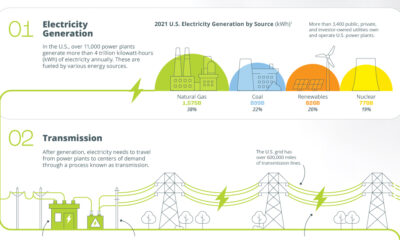
 Electrification1 year ago
Electrification1 year agoVisualized: How the Power Grid Works
-
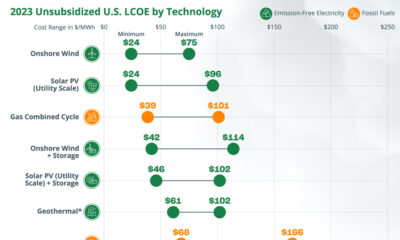
 Energy Shift9 months ago
Energy Shift9 months agoRanked: The Cheapest Sources of Electricity in the U.S.
-
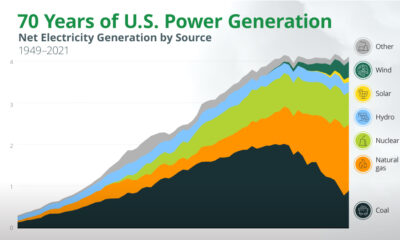
 Energy Shift1 year ago
Energy Shift1 year agoAnimated: 70 Years of U.S. Electricity Generation by Source
-
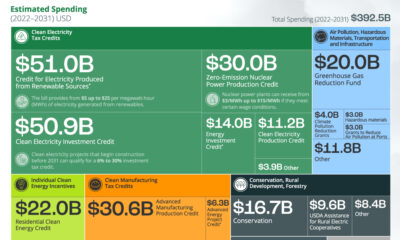
 Clean Energy1 year ago
Clean Energy1 year agoBreaking Down Clean Energy Funding in the Inflation Reduction Act
-
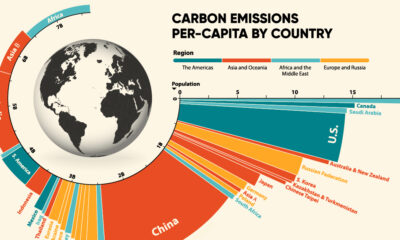
 Emissions1 year ago
Emissions1 year agoVisualizing Global Per Capita CO2 Emissions
-
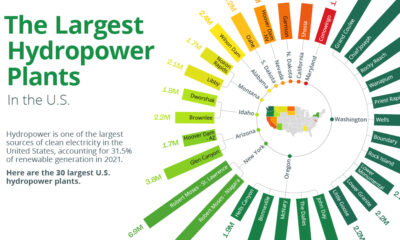
 Clean Energy1 year ago
Clean Energy1 year agoThe 30 Largest U.S. Hydropower Plants
-
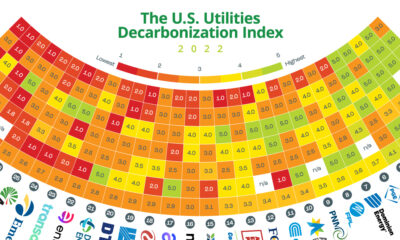
 Decarbonization1 year ago
Decarbonization1 year agoThe U.S. Utilities Decarbonization Index
-
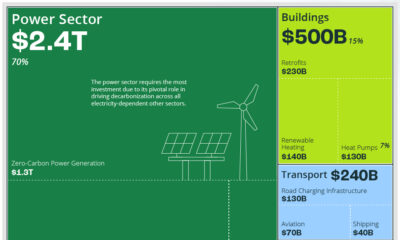
 Clean Energy7 months ago
Clean Energy7 months agoBreaking Down the $110 Trillion Cost of the Clean Energy Transition

